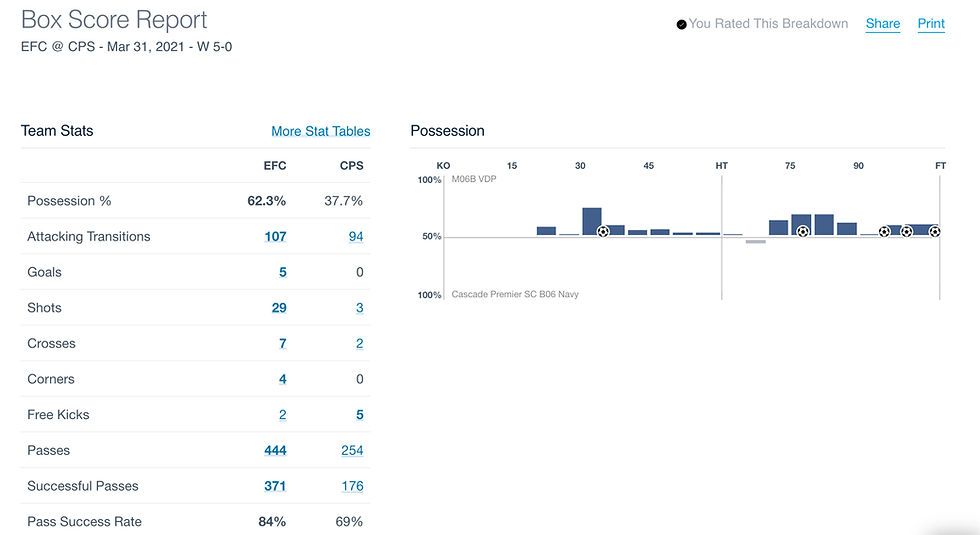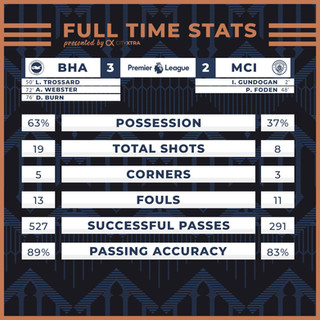Analyzing The Possession Compromise
- Joe Campos

- May 21, 2021
- 10 min read
Updated: May 23, 2021

There is nothing more sublime than watching a Positional Play side move with and without the ball and simply dominate an opponent. It is perhaps the highest collective expression of the beautiful game. I love to watch top professional Positional Play sides, but I especially enjoy watching the young players at Eagleclaw Football Club in my charge trying to play this way.
However, any team aspiring to Positional Play and that specific type of possession-based soccer faces many challenges and vulnerabilities. For example, Positional Play teams can be neutralized somewhat by a quality man-marking side. They can also be punished by teams that sit back, defend in deep compact blocks and look for fast counterattacks and long balls over the top. This is mainly because Positional Play sides tend to play higher up the field leaving more space behind them and fewer players to deal with the counterattack. To play this way means you create certain vulnerabilities for your side. It also means you focus on certain things to the exclusion of others. What becomes important to you may not be as important to others. This is what I call the "Possession Compromise".
Positional Play coaches at the highest levels deal with the Possession Compromise constantly. For every tactical plan the opponent will design a counter-plan. Choosing a possession-based tactical plan means acknowledging you are making tactical compromises and training your team to deal with the resulting challenges. More often than not, possession-based teams do extremely well. Sometimes they are punished.
"Without the ball you can't win. If we have the ball they can't score.'"- Johan Cruyff
To make the point, consider some interesting results in matches involving FC Barcelona and Manchester City, two sides clearly immersed in the Positional Play school of thought. Man City recently lost to Brighton Hove-Albion by a score of 3-2. Looking at the stats, we can see Man City only had 37% percent of the possession, which is uncharacteristically low for them. When they played Newcastle, they had 83% of the possession and won 4-3. It would seem that high rates of possession assure victory, but of course that is not the case. In one of the biggest upsets on the largest stage, the Champions League, Celtic defeated FC Barcelona 2-1. (Highlights here) In that match, Barcelona enjoyed a stunning 89% of the possession, made a total of 955 passes and outshot Celtic 23-5. By the numbers, Barcelona should have won the match handily. To some extent we can chalk it up to the fact that football can be unpredictably cruel, but in my view it is mainly the result of the Possession Compromise.
On balance Cruyff's statement about having the ball is completely true, but not truly complete. The statistical recaps above prove the point. A side that is without the ball for most of the game can still score if they are opportunistic and clinical in front of goal, which is how Celtic defeated Barcelona. Still, as devotees of Positional Play we must train our teams to dominate possession and position and manage the risks of our style of play, confident that having most of the ball gives us the best chance to win.
How should we train possession? The truth is the overwhelming number of youth coaches in this country do not focus enough on the building blocks of possession. They do not effectively train individual possession to serve the goal of collective possession. How many times have you heard a youth coach yelling at their team to keep the ball, while the players struggle to connect two or three passes and then lose the ball? The team can’t keep the ball because the players haven’t been properly trained. To put it simply, collective possession is a function of each player's ability to master individual possession. Individual possession is not about flying changes or isolated 1v1 drills. It is about the full spectrum of abilities that allow a player to receive the ball, keep the ball and pass the ball. So, we need to begin with that definition of individual possession and coach and train the details and finer points of these abilities. This is technical training. Too often, technical training is confused with skill moves like scissors and stepovers, etc. Those are individual technical skills for sure and can help a player keep the ball, but they are neither the most important skills nor foundational skills.
To be proficient in individual possession, the starting point is individual body position. With my players, I like to draw distinctions between how my body is positioned and where on the field I need my body to be positioned. Both must happen in order to help the team collectively keep the ball. From there, we progress to techniques for receiving, passing and shielding. Simultaneously we need to develop players to be spatially and situationally aware, knowing where their teammates are, where they will be and where the opponents are. In general, a Positional Play training session plan should progress from exercises that focus on individual possession to those that focus more on collective possession. By selecting effective training exercises like rondos and positional games, we can use repetition and pattern recognition to build experience, confidence and creativity.

From all of this, we develop what we at Eagleclaw term "technical consistency" and a profile of a competent individual ball possessor emerges as one who consistently:
uses an open body position to increase their field of vision;
receives the ball across their body to the back foot;
adjusts their body quickly and automatically to receive the ball to the back foot, if the ball is played to their front foot;
displays a quality first touch;
can play the ball with either foot after receiving it (two-footed);
is aware of where teammates and opponents are and will be;
finds positions in space to become a better passing option;
senses pressure and can play the ball quickly to the best option;
displays an understanding and awareness of space;
tries to find solutions using teammates, simple passes and space rather than relying first on skill moves in 1v1 situations;
is creative and yet plays simply;
Eleven such players on the field create the potential for collective possession at extremely high rates if the team is also well trained with respect to positional structure. Technical consistency enables structural consistency. Fail to effectively train individual possession and your team will struggle to maintain a rational positional structure and be less effective at keeping the ball.
When you can measure what you are speaking about and express it in numbers, you know something about it. - Lord Kelvin
How do we know how effective we are at training possession? You need to measure. First, though, we need to agree on what we are measuring. If a club, youth soccer coach, their players and their parents are focused on the league table, then that is all they are measuring. That is the problem. The league table tells us nothing about how the team plays. It communicates only a collection of final scores and the number of goals scored. It communicates a result, but nothing about how the result was achieved. Without the "how", we really have no objective and empirical way of measuring the educational growth of our players.
How will you know it is working? How will you know you are being effective at training? You can see it when your team plays. You can see their individual and collective ability to keep the ball, positioning , and tactical understanding. But to really understand how well you are doing as a Positional Play coach takes real data and analysis. You need to focus on data that really informs and helps you adjust your training sessions. If your goal as a coach is to educate players in a modern possession-based style of play, then you need to measure and analyze possession.
Where to start? All you need is determination, a few simple tools and the strength of character to be honest with your players about their developmental progress and back it up with data. It also means you need to give up the focus on the league table and educate your players and parents to do the same. This is definitely part of the Possession Compromise. Sacrifice the ego-centric pursuit of victories that will lose significance over time for the satisfaction of real talent development that will benefit your players for years to come. If you concentrate this way on measurable education, you may lose games, may not win the league and may not win tournaments. But if you do it right, your players will benefit far more than the players of the winning teams.
How do we measure possession? Leading sports data analytics firm Opta, defines a ball possession as starting "upon a player controlling the ball and ends when they no longer do." This approach measures individual possession. The sum of these individual possessions for each team are added and then divided by the total number of possessions to arrive at possession percentages for each side. This is probably the best way to objectively calculate possession for match statistics. For my purposes in training, I typically encourage players to use a different and higher standard: we do not really have "possession" until we connect at least three consecutive passes. In other words, I am focused on "pass strings". Three consecutive passes equals one possession. The difference in the definitions is subtle but important. If I have the ball and promptly turn it over to the opponent, has my team really had possession? Opta's approach counts that as a possession, which is accurate and just fine for measuring final possession statistics. The pass-string approach discounts isolated individual possessions and focuses on moments of collective possession that may tell me more about the strength of each player's individual possession abilities.
At the highest levels, professional clubs have access to incredible technologies and staff dedicated to collecting and analyzing possession data. Fortunately, such technology is increasingly available at the youth level. Services such as Hudl and Playermaker provide deep insights into individual and collective possession. As with any tool, however, the question is whether a coach knows how to use it effectively and does so consistently. With my Valencia Discovery Program (VDP) teams at Eagleclaw FC, I use a combination of these tools to measure how each player is developing. With consistent use of Playermaker at every training session and match, we are able to construct a data mosaic of each player's technical performance over time. We are able to see trends relating to the development of important individual possession traits, especially left/right foot usage and the length of time a player is in possession of the ball. As we try to increase a player's ability to play with both feet, left/right foot usage data is invaluable during training sessions as it helps me intentionally place players in certain roles and positions to drive the player's use of the non-dominant foot. The individual ball possession data helps me understand how often a player is playing quickly and releasing the ball to a teammate, keeping the ball under control or losing possession to an opponent. Often, we can match this data to video of moments in a match to further analyze possession moments and decision-making.
With systems like Hudl and Veo, I am able to use video to look deeper into collective possession as well as individual possession. In particular, Hudl’s Assist service can break down possession rates and pass-strings so I can measure the effectiveness of my training based on how the players perform under pressure in a match. Below is an example of a possession sequences from my M06 VDP and M06B VDP teams. It shows one pass string by each team with many different players touching the ball including the goal keepers. With this kind of information, I can study individual possession habits such as body position, receiving foot, first touch, composure, ability to sense pressure, spatial awareness and more.
Hudl Assist also provides the statistical data so I can dive more deeply into performance aspects of collective possession.




Over the course of a season, a coach can collect, compile and synthesize all of this data for their teams and create a picture of how effective the players and teams are at collective possession. This past season, I used Hudl Assist data and Excel to create a snapshot of the possession statistics for two Valencia Discovery Program teams I currently coach.

There are many important points to be drawn from this consolidated view, too many for this post. Right off the bat, though, it is clear my players were able to dominate possession in nearly every match. The maximum rate of possession achieved was in the range of 63%-66% for both teams. It will be an objective of ours this season to increase that figure even further. The data suggests we are on the right track in terms of developing individual possession, since without individual possession there can be no collective possession. It is also clear, however, that high rates of possession do not translate directly to winning every game. This is precisely the essence of the Possession Compromise for youth coaches. You need to accept there will be losses, learn from them and redouble your effort to develop your players individually and collectively. It is critical to develop young players who are skilled in individual possession and know how to work together as a team to achieve high rates of collective possession. Training players this way helps players continue to playing this sport at high levels. Possession-savvy players are in demand at university soccer programs and professional club academies. Development of players this way is what we are called to do. If you choose to focus on wins and losses and fail to train your players to be skilled in possession, you are letting them down.
For a youth soccer coach aspiring to this high level of play - Positional Play - be proud that you are committed to developing modern youth players in the very best way possible. You must, however, make the many compromises and recognize they begin very early on the training ground. You will need to develop training session plans focused on individual and collective possession. You need to develop players who are technically sound, positionally intelligent and situationally aware. They need to be able to keep the ball and dominate possession. You will need to be consistent and fastidious about measuring the results of your training. It won't be easy. This will take a lot of time and a ridiculous amount of consistent and particularized training and education. You will make decisions to focus on certain types of training over others. Do it and don't waver. Your players will make mistakes and you will lose games. Accept it and stay the course. Unlike the mega-clubs playing in so-called "elite" leagues, you cannot be focused on the league table or chase "elite" leagues. You must be focused on more important data points. Certain players and their parents will walk past your club and team because you are not winning everything today, are not in an "elite" league and they want to be "seen". Let them go while you focus instead on the smart players in front of you, those players who understand learning the highest expression of football takes time and does not permit shortcuts.
Most importantly, remember how much you enjoy watching your team develop and play as a Positional Play side. Remember this especially after the defeats or moments when the team performs below its potential. Developing a Positional Play side takes time and a lot of patience. For inspiration, consider the clip below of Pep Guardiola's press conference after his team lost to Manchester City 2-1. Study his face, his emotions and the tone of his voice. He's been bitten by the Possession Compromise and the defeat stings. This time, the opponent used fast counter attacks to punish Guardiola's team. Notice how he deals with the Possession Compromise. "Sometimes it happens." "Sometimes you lose." Most importantly, consider how often he says he says he likes his team and enjoys watching his team play. This is why we Positional Play coaches stay the course!












This storage unit is a game-changer! The climate control ensures https://www.masterstorage365.com/ my vintage clothes and books remain undamaged. The facility is secure, well-maintained, and easy to navigate. Staff are courteous and always ready to assist. I feel confident storing my treasures here and recommend it for worry-free storage!
I’m thrilled with this wine tour! The breathtaking hillside https://www.vinesandviews.com/ vistas paired perfectly with the smooth, flavorful wines. Our guide’s knowledge and passion brought each tasting to life. The serene landscapes and expertly crafted wines made it a delightful escape. This tour is a must for anyone who loves wine and beauty!
I was pleasantly surprised at how fast and affordable the repair https://preferredgaragedoorsdenver.com/ service was. My garage door had completely stopped opening, and I was stuck. They showed up on time, replaced the broken spring, and even did a full inspection to make sure everything else was working smoothly. Great experience all around.
Naturopathy steadied my sleep with natural tweaks. The rosedale chiropractor herbal teas and routine tips settled me down, and I’m resting better. It’s a gentle shift. I’d urge anyone tossing at night to try it—it’s worked for me.
Harley Street’s consulting rooms are a game-changer for my practice. Sleek clinical room to rent, contemporary interiors paired with cutting-edge technology create a professional atmosphere. The central location impresses clients, and the staff are incredibly supportive. Renting here has elevated my business, offering both prestige and practicality in one package.